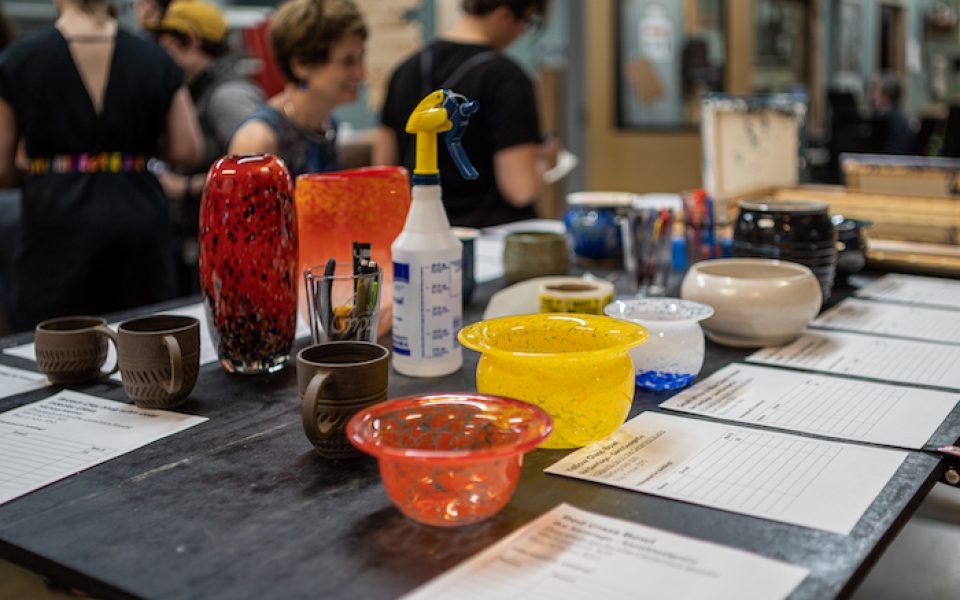Light
from a nearby window ricochets off of yellow orbs hidden in an orange glass
vase. Specks of black and white divide up a similar glass piece in red, while
three small mugs contrast the glass sheen with earthy matte brown finishes.
As
the Made at the Forge auction continues, guests and members circle a handful of
tables displaying an array of donated works as the Saturday sun begins to set.
The vast majority of the items — whether crafted from clay, fabric, metal or
wood — were created within the Forge’s warehouse-esque walls, utilizing tools
and skills procured there.
For the past two years of
its 5-year history, funds from the auction have supported the various areas of
the organization. Executive Director Joe Rotondi explains that the money from
each item goes towards tools and general maintenance for the specific space in
which the piece was made.
Aside from funding the
upkeep of the area, Rotondi believes the auction showcases one of the main
benefits of the community space: the entrepreneurs who bolster their small
businesses here.
“I think there’s a hands-on
spirit here,” he says.
Fabric creations overwhelm
one table, with ID lanyards sitting beside patchwork yoga mat carriers. The
lavender top of a violet rectangular pillow reads, “Ain’t that some shit?” A
dress form stands at the front corner of the table, displaying what designer
Ann Tilley calls a “power vest.” The accessory serves as a bold fashion
statement, with Tilley placing black velvety stripes overtop a block of a mint
color on the front. She adds fringe to the shoulders, and a purple and red
pattern peeks out from the sides. Tilley’s vest appears as an amalgamation of
everything she does in the makerspace’s textile shop, from designing
attention-grabbing concepts to completing seams with the shop’s sewing
machines.

Two folded pairs of pants
sit on display for her other auction item — a custom-made pair of jeans. Tilley
mentions that creating her own clothes has become a habit over the past several
years, believing the practice generates new ideas. She wanted to create custom-fit
to not only raise money but to showcase why textile work remains relevant.
“I feel like sewing is so
out of fashion now,” she says, “so I want to inspire people to come back to the
sewing room.”
Tilley began experimenting
with garments as a pre-teen, and upon finding the Forge a handful of years ago,
used the opportunity to connect with others while completing freelance textile
work. Shortly after joining the makerspace, Tilley took on the role of hosting
the makerspace’s weekly mend-it nights. Now, as a volunteer mentor and one of
the section heads for the Forge’s textile department, Tilley works to share her
skills. She says that everyone should know a few stitches or be able to replace
a button.
“It really does feel good
to give back,” she says, “to teach people skills they can bring home.”
A perusing man asks how
much a large, framed mirror costs, pointing out the corners where rings of
small cuts of wood appear on the surface. The pale-grey standing desk perched
beside him sells an hour into the event.
A small round box brings
back memories for woodworker Phillip Fuentes. Fuentes carved out the shape of
the container, reminiscing about teaching himself from a series of Richard
Raffan VHS tapes and books decades ago.
Its onion-shaped dome
intrigues passersby. Bands of lines round its circumference, appearing at once
both hand-carved and nearly identical in precision. A man places his hand
carefully on its top, avoiding the peak and turns it, the box releasing an
eeking noise as it opens.
Fuentes estimates he joined
the Forge three years ago, utilizing the space to continue his entrepreneurial
woodworking. Now serving as a volunteer mentor and heading up the wood shop,
Fuentes sustains his practice while building anything he can from wood, be it
kayaks or bows and arrows.
Even with the large lasers
and technology-based methods of engraving and carving found in the Forge,
Fuentes prefers the basics, utilizing more traditional approaches and tools.
“I just wanted to do something that was really classic,” he says. “I’m still kind of stuck on older skills.”
Find out more about the Forge online here.
Join the First Amendment Society, a membership that goes directly to funding TCB‘s newsroom.
We believe that reporting can save the world.
The TCB First Amendment Society recognizes the vital role of a free, unfettered press with a bundling of local experiences designed to build community, and unique engagements with our newsroom that will help you understand, and shape, local journalism’s critical role in uplifting the people in our cities.
All revenue goes directly into the newsroom as reporters’ salaries and freelance commissions.


Leave a Reply